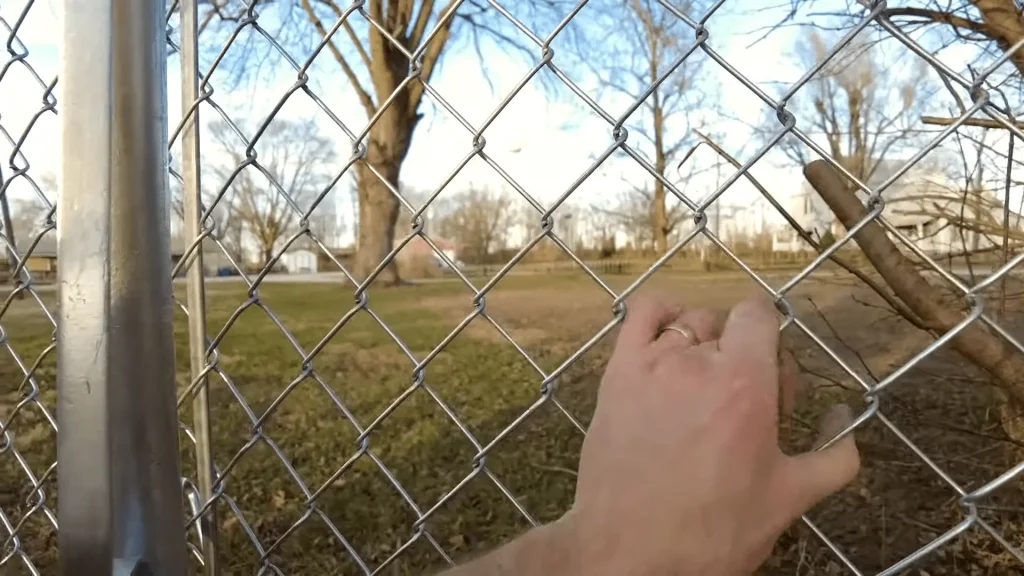How to Stretch Chain Link Fence: Expert Guide
Stretching a chain link fence might seem daunting, but with the right tools and patience, you can do it yourself and achieve professional results. Whether you’re looking to secure your yard, keep pets in, or just add some privacy, learning how to stretch chain link fence is a valuable skill.
To stretch a chain link fence, first attach tension bars to the ends of the fabric. Use a come-along and fence stretcher to pull the fabric tight, ensuring even tension. Finally, secure the fabric to the posts with fence ties and trim any excess.
In this guide, we’ll walk you through each step of the process, from checking the condition of your existing fence to attaching and stretching the chain link fabric.
By the end, you’ll be well-equipped to tackle this project with confidence. So, grab your tools, put on your work gloves, and let’s get started!
Check the Condition of Your Fence

Before diving into the stretching process, it’s crucial to assess the current state of your chain link fence.
Look for any signs of damage or wear, such as rusted or bent posts, loose connections, or torn fabric. Addressing these issues now will save you time and effort later.
If you find any damaged posts, you’ll need to replace them. Use a post hole digger to remove the old post and set a new one in its place, ensuring it’s level and secure.
For minor issues like loose connections or slight bends, you can often make simple repairs using basic tools like pliers or a wrench.
Once you’ve ensured that all posts and connections are in good condition, give the entire fence a thorough cleaning.
Remove any debris, dirt, or vegetation that may have accumulated around the base. This will make the stretching process smoother and help you achieve a neat, professional finish.
List of Materials and Tools Needed
Having the right materials and tools on hand is essential for a successful chain link fence stretching project. Here’s a comprehensive list to get you started:
Materials:
- Chain link fabric
- Tension bars
- Tension bands
- Fence ties
- Tension wire
- Ground stakes (optional)
Tools:
- Come-along
- Fence stretcher
- Pliers
- Wrench
- Post hole digger (if replacing posts)
- Wire cutters
- Tape measure
- Level
- Work gloves
Gathering all these items before you begin will help ensure a smooth workflow and prevent unnecessary trips to the hardware store. Now that you’re equipped with the necessary materials and tools, let’s move on to the actual stretching process.
Attaching and Stretching the Chain Link Fabric
1 – Attaching Tension Bars and Bands
The first step in stretching your chain link fence is attaching the tension bars and bands. Tension bars are essential because they provide the necessary support and distribute the tension evenly along the fence fabric.
Start by threading a tension bar through the end of the chain link fabric. Then, attach this bar to the terminal post using tension bands. Secure the bands tightly with bolts and a wrench, making sure the fabric is evenly distributed along the bar.
Next, repeat this process on the opposite end of the fence. By securing tension bars on both ends, you’ll create a sturdy framework that will make the stretching process more effective and easier to manage.
2 – Using a Come-Along and Fence Stretcher
Now that your tension bars are in place, it’s time to stretch the chain link fabric using a come-along and fence stretcher. These tools are designed to pull the fabric tight and keep it that way while you secure it to the posts.
Attach the fence stretcher to the tension bar on one end of the fabric. Then, connect the come-along to the stretcher and anchor it to a sturdy point, such as a fence post or ground stake. Slowly crank the come-along to begin stretching the fabric. Take your time with this step to ensure the fabric remains evenly tensioned and doesn’t warp or twist.
As you stretch the fabric, periodically check for even tension across the entire length. Adjust the come-along as needed to maintain consistent pressure. This process might require a bit of patience, but it’s crucial for achieving a professional-looking fence.
3 – Securing the Fabric
Once the chain link fabric is properly stretched, you’ll need to secure it to the fence posts. Begin by attaching the fabric to the terminal posts using fence ties or wire ties. Make sure to space the ties evenly, typically every 12-18 inches, to maintain consistent tension.
After securing the fabric to the terminal posts, move on to the line posts. Use pliers to twist the fence ties around the fabric and the post, ensuring a snug fit. Continue this process along the entire length of the fence, double-checking that the fabric remains tight and properly aligned.
If you encounter any slack areas, use the come-along and fence stretcher to make minor adjustments. It’s important to address these issues now to avoid future problems with sagging or loose fabric.
4 – Finishing Touches
With the fabric securely attached, it’s time to add the finishing touches to your chain link fence. First, trim any excess fabric using wire cutters. Be careful to cut cleanly and avoid leaving sharp edges that could pose a safety hazard.
Next, install the tension wire along the top and bottom of the fence. This wire helps maintain tension and adds stability to the fence structure. Attach the wire to the posts using tension bands, and tighten it with a wrench or pliers.
Finally, walk along the entire fence line to inspect your work. Check for any loose ties, uneven tension, or other issues that might need attention. Making these final adjustments now will ensure your fence remains strong and secure for years to come.
Conclusion
Stretching a chain link fence may seem challenging at first, but with the right approach and tools, it’s a manageable DIY project that can significantly enhance your property’s security and appearance. By following this step-by-step guide, you’ll be able to achieve professional results and gain the satisfaction of completing a project on your own.
Remember to take your time, double-check your work, and don’t hesitate to ask for help if needed. Whether you’re a seasoned DIY enthusiast or a beginner, this guide provides all the information you need to stretch a chain link fence successfully.
Related Articles:

